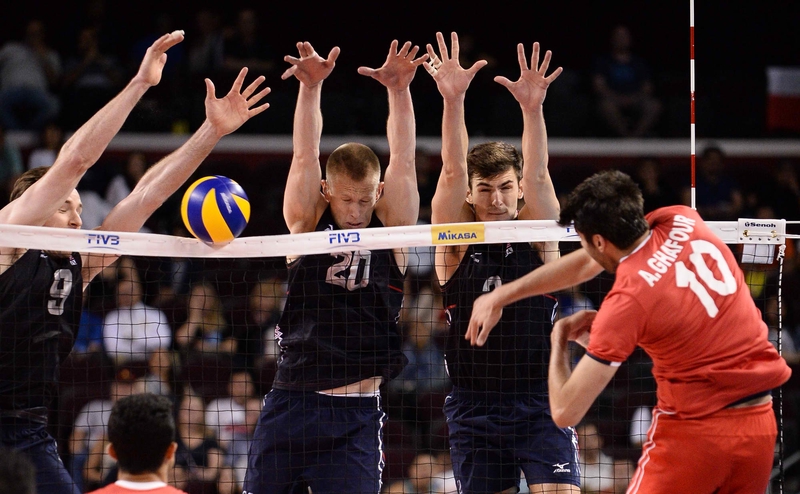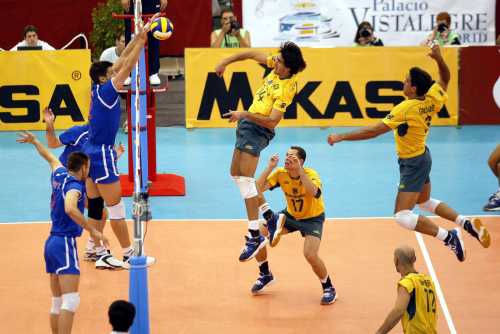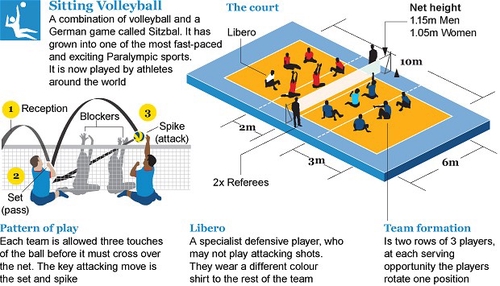I believe many of you are quite familiar with Volleyball, and we used to play this kind of sport in some other time or we regularly watch this game. This is another sport that I like, a sport that requires the skill of smashing, blocking and serving. I remember, the guy Aris Munandar, a local volleyball who owned the recognization of his skill of playing the volleyball but he is probably too old now to show us the way he attacks the ball, at his time, he was more terrified attacker. But on this occasion, I don't talk about this guy, I just want to talk a bit about volleyball that is placed in the famous rank of the sport. Indoor volleyball is not as easy as it look, not just serving the ball and leave it on the floor. Nope! Volleyball is not only involved the muscle but the sense is important to understand, like eyes code, finger code which is made by the player when serving the ball and the player rotation and formation that will be also becoming an impact of the gameplay. Just like other sports, volleyball players also need to know better about the basic layout of the court and the right position to get the ball.

Volleyball Court Layout
The court is 9 meter by 18 meters. It is divided the entire by the net, each team will the occupy the 9 meter by 9 meters, and designate that as their court. This 18 meter by 9-meter court is a standard dimension. The court is surrounded by a free zone, 3 meters wide at all sides while free playing space must meet the minimum of 7 meters in height from playing surface. For World and Official Competition, the free zone must meet the minimum of 5 m from the sidelines and 8 m from the end line while free playing space is measured a minimum 0f 12.5 m in height. The court is divided into two zones per half-court. Like the frontcourt, the area where the attack takes place also know as 3m line and the backcourt which sits behind the attack line that consists of three players that stand on each of zone. The front row, right in front of the net the player use this position to block the opponent and attack the ball in the attack zone. We, as non-player, don't notice when the player moves and back to the same zone, we then wonder why a particular player stick on the same zone. We must understand, each player has different assignment or skill in volleyball just like football, but their role can be replaced by another player sometimes. It indicates that each player, at least, must own the skill of blocking, smashing, serving and attacking. Let's say, the most expected player that he/she will score the point is the attacker who dominates the back row and plays defense to dig the opponent's attack the ball behind the attack line. The indoor volleyball courts have met the official characteristic that may allow the players to recognize their position.

Boundary lines: Mark the court’s perimeter and include the end lines to mark the length, and the sidelines to mark the width, of the court.
Net: The ball must be hit over a net placed approximately seven and a half feet above the ground for girls and eight feet for boys.
Antennae: Poles sticking up from each side of the net that signify the court sidelines. Any ball contacting or hit outside the antennae is considered out of bounds.
Attack lines: Separates the frontcourt from the backcourt. Back-row players may only jump from behind this line (must jump before line, but may land on other side). Also called 3-meter line.
Frontcourt: Area between net and attack line where front-row players are positioned.
Backcourt: Area between the attack line and the end line where back-row players are positioned.
Centerline: Line directly below the net that divides the court in half. A fault is called if a player crosses this line with any part of the body (a player may touch line, but not cross it).
Service area: Space beyond either end line where a player stands while serving.

Volleyball Players
Volleyball consists of six players in each team and six rotational zones. The zone or spots are usually dominated by the position specialist, I mean the player who must be able to take each serve-three the front row. In the front row, line up three other rows that must be filled such as left-front, center front, and right-front so the back row that is also divided into three such as the left-back, center-back, and right-back. The player who is in the right-back spot the serves that go to the front row until to the attacker who takes the position at the left side or right side allow the blocker to block the attack from attacker depends on what side the attack hit the ball. The rotation is made to force the players into spots that are away from their optimal positions, so the player switches, or run to the ideal positions once the ball served. Then, the players rotate clockwise on the court after scoring point and after the opponent's serve the ball. While playing the volleyball, the players have rotational positions on the court to a different zone that allow the players to move to their playing positions. While being on switched position, three players who dominate the front row are responsible to make sure that ball cross over the net to the opponent's side and the players who take the position on the back row are responsible to receive the ball, and in any chance, they can also attack the ball. The players themselves consist of setter, outside hitter, middle blocker, opposite, libero.

Setter: Passing specialist who usually hits the second ball of the rally to set up a spike for a teammate. The setter is always close to the net, faces the left sideline, and can set the ball forward or backward to the hitter that is ready to attack.
Outside hitter: Attacker who spikes the ball over the net from the front left position. Also blocks spikes from the other team.
Middle blocker: Defensive specialist who assists the other two front-row players in blocking all shots from the opposing team. Also spikes ball from the middle of the court.
Opposite: Attacker who plays in the front right of the court when the setter is in the back row.
Libero: Back-row defensive specialist who has fast reaction time and is an excellent passer. Specializes in receiving serves and attacks by bumping or digging the ball. Wears a different colored jersey, does not serve or block, and can substitute unlimited times in and out of the back row without waiting for the referee’s approval. This position was created in 1998 and will be implemented at the high school level by the 2006-2007 season.
Server: A player who start the rally, the serves position is on serving area, at the end of the court that may allow the player to pass the ball to the oppisite team. Best server will often make the gameplay so alive.
The Volleyball's Rule
We sometimes get confused when the referee blows the whistle and wonder why, and then we pay a close notice to the cause. We just know one of the players has broken the rule, just like the football, we don't know in detail. In volleyball, the rule is much concerned and may decide the integrity of the player, but it is not so complicated that we drive us to know what are those rule.
-Each team consist of six play, 3 on the front row and 3 on the back row
-A player may not hit the ball twice in succession (a block is not considered a hit)
-Ball pass the net and the ball hit the boundary line is in
-The ball hit the antenna is out
-It is allowed to contact the ball with any part of a body
-Catching, holding and throwing the ball are illegal
-Three hits maximum per side
-A player can not block or attack a serve from on or inside the 10 foot line
-After the serve, front line players may shift the positions at the net
At higher competition, the officiating crew may be made up of two refs, line judges, scorer, and an assistant scorer
Conclusion
Volleyball is a sport that is played by two teams, consisting of six players in each team. The volleyball has been going throughout centuries and becoming a quite familiar sport in many countries. The aim of the game is to pass the ball over the net toward the opponent's court, and prevented by the technique like blocking and other efforts to send back the ball to the opponent's side. Each team may hit the ball not more than three hits and a player can not hit the ball twice in succession. Volleyball is considered as a complex game of simple skills, that is the player spikes up to 60 cm above the height, and power is a vital component of the players, but the skill, tactic, strategies are the cores to win the game. The volleyball is mostly played in indoor spaces and considering as a common sport that can be played anywhere, in the backyards, hall, on the back, outdoor on a ground, and indoor courts that must apply the dimensions of a volleyball courts need to the same with regular dimension.
References
Comments